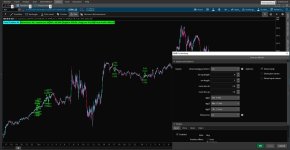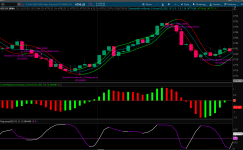congamike
New member
Many years ago, when I screened fundamentals for a company, I discovered that "up for the week, month, and quarter", added value to my boss's list of parameters.
Now that I am applying STRAT principles to scalping, I am tied to Time Frame Continuity even more tightly.
So, what is "Bullish," what is "Bearish?" Red and green candles make that determination I am told. The only other condition is consolidation.
In my experience, there is a fourth: I refer to it as "Screaming". Screaming may be observed by viewing Bollinger Bands. Any activity outside of the bands is very interesting indeed. Trending and consolidating is also easily identifiable. John Bollinger even has a book that teaches the use of his bands. Good stuff and highly recommended. I ultimately went with Standard Error Bands because I see less overshoot.
So with these bands, with tight parameters, trading on the 2 minute chart with permission of the 15 minute chart, I began making a profit in my demo account. Feel free to adapt the time frames to your preference.
The Standard Error band study and the Bollinger band study is already provided for us.
In this script, I add color to Error bands so that only absolute consolidations are white. Bullish and bearish conditions are decorated with Christmas colors. Pretty simple stuff but it may help clear up some brain fog some fine day.
Further embellishments to follow..
Here is the code (and my first script offering here).
</>
# 9-27-23 congamike
input price = close;
input linRegLength = 10;
input smLength = 3;
input displace = 0;
input Num_Dev_Dn = -1.0;
input Num_Dev_Up = 1.0;
def value = Average(Inertia(price[-displace], linRegLength), smLength);
def error = Average(sterr(price[-displace], linRegLength), smLength);
#plot MidLine = value;
plot LowerBand = value + Num_Dev_Dn * error;
plot UpperBand = value + Num_Dev_Up * error;
#MidLine.SetDefaultColor(GetColor(5));
UpperBand.SetDefaultColor(GetColor(8));
LowerBand.SetDefaultColor(GetColor(8));
def UDiff = UpperBand - UpperBand[1];
def DDiff = LowerBand - LowerBand[1];
UpperBand.AssignValueColor(if UDiff > .1 then Color.UPTICK else if UDiff < -.1 then Color.DOWNTICK else Color.WHITE);
LowerBand.AssignValueColor(if DDiff > .1 then Color.UPTICK else if UDiff < -.1 then Color.DOWNTICK else Color.WHITE);
Now that I am applying STRAT principles to scalping, I am tied to Time Frame Continuity even more tightly.
So, what is "Bullish," what is "Bearish?" Red and green candles make that determination I am told. The only other condition is consolidation.
In my experience, there is a fourth: I refer to it as "Screaming". Screaming may be observed by viewing Bollinger Bands. Any activity outside of the bands is very interesting indeed. Trending and consolidating is also easily identifiable. John Bollinger even has a book that teaches the use of his bands. Good stuff and highly recommended. I ultimately went with Standard Error Bands because I see less overshoot.
So with these bands, with tight parameters, trading on the 2 minute chart with permission of the 15 minute chart, I began making a profit in my demo account. Feel free to adapt the time frames to your preference.
The Standard Error band study and the Bollinger band study is already provided for us.
In this script, I add color to Error bands so that only absolute consolidations are white. Bullish and bearish conditions are decorated with Christmas colors. Pretty simple stuff but it may help clear up some brain fog some fine day.
Further embellishments to follow..
Here is the code (and my first script offering here).
</>
# 9-27-23 congamike
input price = close;
input linRegLength = 10;
input smLength = 3;
input displace = 0;
input Num_Dev_Dn = -1.0;
input Num_Dev_Up = 1.0;
def value = Average(Inertia(price[-displace], linRegLength), smLength);
def error = Average(sterr(price[-displace], linRegLength), smLength);
#plot MidLine = value;
plot LowerBand = value + Num_Dev_Dn * error;
plot UpperBand = value + Num_Dev_Up * error;
#MidLine.SetDefaultColor(GetColor(5));
UpperBand.SetDefaultColor(GetColor(8));
LowerBand.SetDefaultColor(GetColor(8));
def UDiff = UpperBand - UpperBand[1];
def DDiff = LowerBand - LowerBand[1];
UpperBand.AssignValueColor(if UDiff > .1 then Color.UPTICK else if UDiff < -.1 then Color.DOWNTICK else Color.WHITE);
LowerBand.AssignValueColor(if DDiff > .1 then Color.UPTICK else if UDiff < -.1 then Color.DOWNTICK else Color.WHITE);
Last edited:


